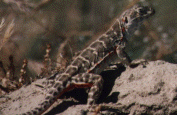Blunt-nosed leopard lizard facts for kids
Quick facts for kids Blunt-nosed leopard lizard |
|
|---|---|
 |
|
| Conservation status | |
| Scientific classification | |
| Genus: |
Gambelia (lizard)
|
| Species: |
sila
|
| Synonyms | |
|
|
The blunt-nosed leopard lizard (Gambelia sila) is a special type of lizard. It belongs to the family called Crotaphytidae. This lizard is found only in southern California, meaning it's endemic to that area. It's known for its short, blunt snout, which gives it its name.
Contents
About the Blunt-Nosed Leopard Lizard
How it Got its Name
The blunt-nosed leopard lizard was first described in 1890 by a scientist named Leonhard Stejneger. He first called it Crotaphytus silus. Later, in 1900, another scientist thought it was a type of long-nosed leopard lizard.
In 1946, scientists looked closely at its head shape and other features. They decided it was different enough to be placed in its own genus called Gambelia. This is why its scientific name became Gambelia silus. The name was later changed slightly to Gambelia sila to match grammar rules. Lizards in the Gambelia genus are similar to those in the Crotaphytus genus. However, Crotaphytus lizards can break off their tails if a predator grabs them. This is a cool defense mechanism!
Where it Lives
The blunt-nosed leopard lizard lives only in Southern California. It used to be found across a much larger area. This included the San Joaquin Valley and nearby hills. It lived in places up to 800 meters (about 2,600 feet) high.
Today, you can only find these lizards in small, separate areas. These are undeveloped parts of the San Joaquin Valley. Some of these places include the Ciervo Hills and Carrizo Plain. Scientists are working to protect these areas.
What it Eats
The blunt-nosed leopard lizard is a predator. Its main diet includes different invertebrates and other lizards. It loves to eat insects like grasshoppers, beetles, bees, wasps, and ants.
Sometimes, this lizard will even eat other kinds of lizards. It might even eat its own young! It's a very fast and skilled hunter. It can leap up to 60 centimeters (about 2 feet) to catch its prey. This makes it very good at finding food.
What it Looks Like
The blunt-nosed leopard lizard is a fairly large lizard. It has a long tail that can grow back if it breaks off. It also has strong back legs and a short, blunt nose.
Adult males are a bit bigger than females. Males are usually about 3.4 to 4.7 inches long, not counting their tails. Females are 3.4 to 4.4 inches long. Their weight is also different, with males being heavier.
Their skin color can change. It ranges from yellowish-brown to dark brown. This helps them blend in with the soil and plants around them. Their belly is always white. They have dark spots on their back. These spots alternate with white, cream, or yellow bands.
During breeding season, both males and females get special colors. Females get bright red-orange marks on their heads, bodies, and under their legs and tail. Males might get a salmon to rusty-red color on their undersides. Young lizards also have a unique yellow color under their back legs and tails. Scientists think this yellow color might be a signal to adult lizards. It could mean they are too small to breed. Or, it might help them avoid predators.
How They Breed
The breeding season for the blunt-nosed leopard lizard starts in April and lasts until June. During this time, male and female pairs are often seen together. They might even share the same burrows.
In June and July, females lay 2 to 6 eggs. The eggs are about 15.6 by 25.8 millimeters (0.6 by 1 inch) in size. Females usually lay one group of eggs each year. After about two months, the young lizards hatch. They are about 42 to 48 millimeters (1.6 to 1.9 inches) long when they are born. Some young lizards can double their size before their first winter.
During breeding, males and females show different behaviors. Males might do a "headbob" or a "pushup" movement. They also have special displays for fighting other males. When two males fight, they try to bite each other. They also lash their tails and jump. Females have a special "rejection posture" if a male tries to mate when she is not ready. She will arch her back, puff up her body, and open her mouth.
Conservation Status
The blunt-nosed leopard lizard is an endangered species. Both the United States government and the State of California list it as endangered. This means it needs special protection.
Its numbers have dropped a lot. This is mainly because its habitat (the place where it lives) has been destroyed or broken up. This happens because of new buildings and other changes to the land. This lizard used to live all over the San Joaquin Valley. Now, it only lives in a few small, undeveloped areas.
The San Joaquin Valley is a desert. It's changing because of new types of non-native grasses. These grasses might have spread because of grazing cows. Scientists think these new plants are changing the lizard's environment. This makes it harder for the blunt-nosed leopard lizard and other small animals to survive.
However, some studies show that continued grazing by cattle can actually help. It can keep the spread of these new grasses under control. This has led to an increase in the population of the blunt-nosed leopard lizard and other animals in the Valley.


